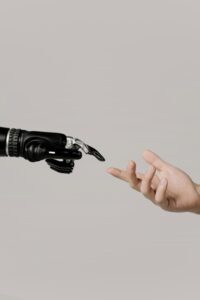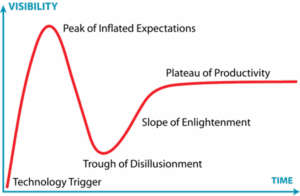How Disruptive is AI?
Examining the Narrative Behind the Hype

By: Olivia Arechiga, Co-Founder – Line Axia
(AI acknowledgement: this post was written by a human, me! I used ChatGPT-4 to fact check a few items, confirm sources, and to answer a few specific questions).
“People worry that computers will get too smart and take over the world. But the real problem is that they’re too stupid and they’ve already taken over the world.”—
Pedro Domingos, computer science professor, University of Washington. 2015.
Artificial Intelligence (AI) has been hailed as a force of radical disruption.
We’ve all heard the fear-mongering and the siren songs: AI will take over the world, AI will replace humans, AI will solve & cause immense problems. All major tech CEO’s have something profound to say on AI, and all seem to think they are right. From healthcare and finance, to logistics, media, and legal services, nearly every industry is bracing for an up-ending transformation.
Just look at your LinkedIn feeds – it seems there every third post is about how AI solved X problem, or spouting their opinion on AI, hoping you’ll think of them as an expert on the subject.
But as organizations rush to integrate large language models, predictive analytics, and workflow automation tools, it’s worth asking a more fundamental question: Is AI truly “disruptive”, and “revolutionary”, or is it just the next logical phase in digital evolution?
This post takes a measured look at what disruption really means in practice, how AI is unfolding in real organizations, and why leaders should temper both fear and hype with critical analysis.
First off, let’s define “Disruption”
For the sake of this post, we’re sticking with the definition used by Clayton Christensen, in his 1997 book “The Innovator’s Dilemma”.
In it, Christensen describes a specific and unique kind of market shift; the theory of disruptive innovation. Disruptive innovation in this context, is innovation that creates a new value network, often entering at the bottom of an existing market, and eventually displacing established market-leading firms, products, and alliances.
In this sense, disruption is not about radical new technologies per se, but about business model displacement and transformation.
Through this lens, AI’s disruptive potential depends less on how technically advanced it is, and more on how it restructures value chains and redefines who captures the margin. So far then, it seems many AI use cases are powerful, but largely adjunctive, and not truly destabilizing.
“Take a look at software developers. It’s not hard to see AI can help software engineers, and help optimize their workflows, but not to the extent that it can replace them. Illustrating this point much better than me, is GitClear’s founder warning that AI tools are generating “AI-induced tech debt,” with code churn increasing, and hastily added code, creating substantial maintainability challenges.
Emily Bender (noted AI skeptic and professor at the University of Washington for Computational Linguistics Laboratory) wrote a piece in the Financial Times, June 2025, in which she called LLMs “stochastic parrots” and “plagiarism machines” lacking real understanding; the boom being built on misconceptions that mask their limits and costs.”
But we know AI has had a direct effect on jobs. So who Is Actually Being Displaced? And is this a permanent change?
As with any “disruptive” technology or change, the process by which it integrates itself into society is messy in its regulatory and societal integration. The market effect therefore is inconsistent and often painful. The key is distilling what is real and lasting change, and what is the overreaction of tech leaders trying to temporarily improve their bottom line and stay ahead of the perceived curve.
The more significant disruptions we have seen are at the service layer, not the strategic core. A few examples:
- Freelancers in design, content writing, and translation are already seeing pricing pressures as AI models produce similar content and products at no or very low cost.
- Customer support outsourcing is being re-evaluated in light of 24/7 AI agents.
- More on this later, but more businesses are looking at replacing customer support with AI agents and AI bot support.
In these sectors, AI may indeed be commodifying a sector of specialized labor. But in regulated, high-stakes, or relational contexts like healthcare, law, consulting, public sector- AI tools remain assistants, not substitutes.
Additionally, the displacement effect, where it exists, is fragmented and uneven.
It seems then, what we’re talking about here is more evolutionary than revolutionary.
- Routine cognitive tasks (data entry, document summarization) are vulnerable.
- Manual and low-wage jobs in unpredictable environments (e.g., skilled care work, construction) remain largely resistant.
- Highly skilled knowledge work (e.g., law, medicine) may become augmented, not displaced.
Why “Disruption” Isn’t Inevitable
First off, AI is not a monolith.
It encompasses an array of technologies: machine learning, natural language processing, computer vision, recommendation algorithms, generative models- each with different maturity levels and use cases. Generative AI (like what you use Claude or Chat-GPT5 to write your emails or create an image), is all the rage at the moment.
But most “AI” embedded in industry today is still narrow and purpose-built– automating specific tasks (e.g., fraud detection, predictive maintenance, customer support chat-bots), not reinventing entire workflows or job categories.
It is, plainly, falling short of its promises.
Gartner’s “trough of disillusionment” comes to mind.

https://www.economist.com/business/2025/05/21/welcome-to-the-ai-trough-of-disillusionment
There are several high-profile examples of AI pilots programs stalling in what Gartner calls its “trough of disillusionment.” Are we currently sitting at the “Peak of Inflated Expectations?”, or somewhere near there?
Think back to “Humane”, the company who launched a buzzy wearable AI device- the AI Pin- as a high-profile proof-of-concept. By mid-2024, operations were halted. The product didn’t transform user interaction and failed to live up to expectations, illustrating a classic “nice demo, but no mass-market product” scenario.
A recent article by Live Mint, highlighted 42% of companies are abandoning most GenAI pilot projects, citing frustrated Chief Executives who feel the money has been spent without delivery.
And a 2024 report from MIT Sloan found that only 23% of firms using AI reported significant impact on core business models.
The questions now are, are these just the messy, contradictory market convulsions we tend to see with disruptive technologies? Where hype and marketing don’t align with operability, scale, and function? Is AI ever going to actually, substantially, and permanently disrupt our economies and workflow?
Labor Market Shifts Will Be Gradual- And Messy
The claim that AI will replace vast swaths of the workforce is not baseless, but it is definitely oversimplified.
Technological capability alone does not guarantee success. Just because you successfully integrated an AI chatbot tool into your stack to replace 75% of your call-center agents, does not mean that it will produce a net-positive for your business. We’ve seen big changes and hasty-layoffs now, as businesses scurry to reduce their bottom line and integrate fancy and exciting AI tools, but the reality of AI is that it is still pretty bad at most tasks. (Who here has had to work with an AI customer service agent? I have, and it’s been veritably terrible each and every time). Those that integrate AI tools too early or hastily, get their feedback quickly in the market response by the consumer.
We don’t need to look too far for a few notable examples:
- Klarna – After replacing 800 customer service staff with AI chatbots, Klarna found that customer satisfaction dropped “significantly”. Klarna then reversed course, rehiring human agents to ensure customers “always have the option to speak with a real person”.
- IBM – Replaced many HR roles with an AI bot (“AskHR”), but found the system failed to replicate human empathy and judgment. IBM then rehired staff to fill those gaps in their HR division.
- Duolingo -Declared it would become “AI‑first” in a near-viral message that was all over social media. They laid off 10% of its workforce. Its intention was to use AI to replace contractors for translation, amongst other tasks. Within a week, it reversed course: CEO Luis von Ahn clarified they’d continue normal hiring, using AI as a tool to “assist rather than replace” employees.
But on the other hand, we see things like Amazon’s CEO Andrew Jassy announcing “he expects the rise of generative AI to “reduce” Amazon’s corporate workforce over the coming years”.
So what are we to think?
Well, tech giants have everything to gain in perpetuating the idea that AI is, and will continue to, disrupt our modern workforce as we know it.
Narrative = Valuation: Market history shows us publicly traded tech companies benefit when they’re seen as innovators. Framing AI as a transformative force boosts investor enthusiasm, driving up stock prices.
Capital Inflows: VC and institutional funding favor “AI-forward” firms. AWS, for example, can undoubtedly attract more clients and partners by emphasizing AI as the future.
Market Perception: If Amazon for example doesn’t talk about AI, it may look like it’s falling behind peers like Google, Microsoft, or Meta. Public statements maintain a perception of technological leadership – no matter how realistic, effective, or devastating those plans might turn out to be.
“Inevitable Future” Mentality: If workers, governments, and competitors believe that AI adoption is inevitable, it becomes a self-fulfilling prophecy. Dissenters look regressive or inefficient. Companies are afraid to be left behind. Talking about AI begets talking about AI.
Social License to Automate: Calling AI a “revolution” provides a certain level of moral and economic cover for hard-to-defend decisions… like replacing human roles.
In reality though, there are still enormous, dynamic hurdles AI needs to clear- before it can even be considered an actual revolution.
- In healthcare, AI diagnostic tools face strict regulatory review, data residency laws, and major ethical scrutiny.
- In legal practice, issues of privilege, authorship, and jurisdiction make full automation of legal reasoning unlikely in the near term.
- In finance, auditability and explainability remain major barriers to black-box AI adoption.
- Government regulation and compliance: the EU AI-Act has been touted as the most aggressive and far reaching regulation surrounding AI to date. Yet it’s hitting big roadblocks, with integration and adherence planning at the near foregone conclusion that it will be delayed.
What we’re actually seeing instead is selective adoption– AI being used tactically, not structurally, in environments where trust and accountability still matter more than speed or cost.
What Leaders Should Actually Focus On
Rather than asking whether AI will disrupt their industry, organizations might get farther by asking:
- Where does AI offer immediate value without compromising risk posture?
- Which workflows can be streamlined without undermining human oversight?
- How should governance evolve to integrate AI responsibly and strategically?
- What talent and skills will be needed to translate AI outputs into real-world impact?
The true differentiator won’t be which company has the most aggressive and highest number of AI tools, but which ones can integrate them sustainably, and meaningfully within their operational model and stakeholder context.
And it’s important to remember, disruption is not uniform. It is filtered through economics, regulation, unionization, ethical boundaries, and social context.
Final Thoughts
AI is significant. But disruption is not a foregone destiny. The most likely scenario is not an AI revolution, but an AI diffusion, a gradual, uneven, messy integration into the workflows of institutions that are already adapting to other transformations: remote work, data localization, ESG reporting, and platform consolidation.
For leaders, the real work lies not in reacting to headlines (or even stock prices), but in building the operational discipline to assess, adopt, and govern AI technologies in proportion to their actual impact.
